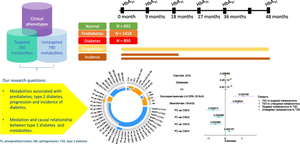Diabetologia ( IF 8.4 ) Pub Date : 2024-09-30 , DOI: 10.1007/s00125-024-06282-6 Sapna Sharma, Qiuling Dong, Mark Haid, Jonathan Adam, Roberto Bizzotto, Juan J. Fernandez-Tajes, Angus G. Jones, Andrea Tura, Anna Artati, Cornelia Prehn, Gabi Kastenmüller, Robert W. Koivula, Paul W. Franks, Mark Walker, Ian M. Forgie, Giuseppe Giordano, Imre Pavo, Hartmut Ruetten, Manolis Dermitzakis, Mark I. McCarthy, Oluf Pedersen, Jochen M. Schwenk, Konstantinos D. Tsirigos, Federico De Masi, Soren Brunak, Ana Viñuela, Andrea Mari, Timothy J. McDonald, Tarja Kokkola, Jerzy Adamski, Ewan R. Pearson, Harald Grallert

|
Aims/hypothesis
Type 2 diabetes is a chronic condition that is caused by hyperglycaemia. Our aim was to characterise the metabolomics to find their association with the glycaemic spectrum and find a causal relationship between metabolites and type 2 diabetes.
Methods
As part of the Innovative Medicines Initiative - Diabetes Research on Patient Stratification (IMI-DIRECT) consortium, 3000 plasma samples were measured with the Biocrates AbsoluteIDQ p150 Kit and Metabolon analytics. A total of 911 metabolites (132 targeted metabolomics, 779 untargeted metabolomics) passed the quality control. Multivariable linear and logistic regression analysis estimates were calculated from the concentration/peak areas of each metabolite as an explanatory variable and the glycaemic status as a dependent variable. This analysis was adjusted for age, sex, BMI, study centre in the basic model, and additionally for alcohol, smoking, BP, fasting HDL-cholesterol and fasting triacylglycerol in the full model. Statistical significance was Bonferroni corrected throughout. Beyond associations, we investigated the mediation effect and causal effects for which causal mediation test and two-sample Mendelian randomisation (2SMR) methods were used, respectively.
Results
In the targeted metabolomics, we observed four (15), 34 (99) and 50 (108) metabolites (number of metabolites observed in untargeted metabolomics appear in parentheses) that were significantly different when comparing normal glucose regulation vs impaired glucose regulation/prediabetes, normal glucose regulation vs type 2 diabetes, and impaired glucose regulation vs type 2 diabetes, respectively. Significant metabolites were mainly branched-chain amino acids (BCAAs), with some derivatised BCAAs, lipids, xenobiotics and a few unknowns. Metabolites such as lysophosphatidylcholine a C17:0, sum of hexoses, amino acids from BCAA metabolism (including leucine, isoleucine, valine, N-lactoylvaline, N-lactoylleucine and formiminoglutamate) and lactate, as well as an unknown metabolite (X-24295), were associated with HbA1c progression rate and were significant mediators of type 2 diabetes from baseline to 18 and 48 months of follow-up. 2SMR was used to estimate the causal effect of an exposure on an outcome using summary statistics from UK Biobank genome-wide association studies. We found that type 2 diabetes had a causal effect on the levels of three metabolites (hexose, glutamate and caproate [fatty acid (FA) 6:0]), whereas lipids such as specific phosphatidylcholines (PCs) (namely PC aa C36:2, PC aa C36:5, PC ae C36:3 and PC ae C34:3) as well as the two n-3 fatty acids stearidonate (18:4n3) and docosapentaenoate (22:5n3) potentially had a causal role in the development of type 2 diabetes.
Conclusions/interpretation
Our findings identify known BCAAs and lipids, along with novel N-lactoyl-amino acid metabolites, significantly associated with prediabetes and diabetes, that mediate the effect of diabetes from baseline to follow-up (18 and 48 months). Causal inference using genetic variants shows the role of lipid metabolism and n-3 fatty acids as being causal for metabolite-to-type 2 diabetes whereas the sum of hexoses is causal for type 2 diabetes-to-metabolite. Identified metabolite markers are useful for stratifying individuals based on their risk progression and should enable targeted interventions.
Graphical Abstract
中文翻译:

来自 IMI-DIRECT 研究的人血浆代谢物在糖尿病前期和 2 型糖尿病中的作用
目标/假设
2 型糖尿病是一种由高血糖引起的慢性疾病。我们的目标是表征代谢组学,以找出它们与血糖谱的关联,并找到代谢物与 2 型糖尿病之间的因果关系。
方法
作为创新药物倡议 - 糖尿病患者分层研究 (IMI-DIRECT) 联盟的一部分,使用 Biocrates AbsoluteIDQ p150 试剂盒和 Metabolon 分析测量了 3000 份血浆样品。共有 911 种代谢物 (132 种靶向代谢组学,779 种非靶向代谢组学) 通过质量控制。根据每种代谢物的浓度/峰面积作为解释变量,将血糖状态作为因变量计算出多变量线性和 logistic 回归分析估计值。该分析在基本模型中针对年龄、性别、BMI、研究中心进行了调整,在完整模型中还针对酒精、吸烟、血压、空腹高密度脂蛋白胆固醇和空腹三酰甘油进行了调整。统计显著性在整个过程中进行了 Bonferroni 校正。除了关联之外,我们还研究了分别使用因果中介检验和双样本孟德尔随机化 (2SMR) 方法的中介效应和因果效应。
结果
在靶向代谢组学中,我们观察到 4 (15)、34 (99) 和 50 (108) 种代谢物(在非靶向代谢组学中观察到的代谢物数量出现在括号中),在比较正常葡萄糖调节与葡萄糖调节受损/糖尿病前期、正常葡萄糖调节与 2 型糖尿病和葡萄糖调节受损与 2 型糖尿病时,它们存在显著差异。重要的代谢物主要是支链氨基酸 (BCAA),还有一些衍生的 BCAA、脂质、外源性物质和一些未知物。溶血磷脂酰胆碱 a C17:0 等代谢物、己糖总和、BCAA 代谢氨基酸(包括亮氨酸、异亮氨酸、缬氨酸、N-乳酰缬氨酸、N-乳酰亮氨酸和甲酰谷氨酸)和乳酸,以及未知代谢物 (X-24295),与 HbA1c 进展率相关,并且是从基线到 18 个月和 48 个月随访的 2 型糖尿病的重要介质。2SMR 用于使用来自英国生物样本库全基因组关联研究的汇总统计数据来估计暴露对结果的因果影响。我们发现 2 型糖尿病对三种代谢物(己糖、谷氨酸和己酸盐 [脂肪酸 (FA) 6:0])的水平有因果关系,而脂质如特异性磷脂酰胆碱 (PC)(即 PC aa C36:2、PC aa C36:5、PC ae C36:3 和 PC ae C34:3)以及两种 n-3 脂肪酸硬脂糖酸酯 (18:4n3) 和二十二碳五烯酸酯 (22:5n3) 可能在 2 型糖尿病的发展中起因果作用。
结论/解释
我们的研究结果确定了已知的 BCAA 和脂质,以及与糖尿病前期和糖尿病显着相关的新型 N-乳酰氨基酸代谢物,它们介导了糖尿病从基线到随访(18 个月和 48 个月)的影响。使用遗传变异的因果推断表明,脂质代谢和 n-3 脂肪酸的作用是代谢物到 2 型糖尿病的因果关系,而己糖的总和是 2 型糖尿病到代谢物的因果关系。已确定的代谢物标志物有助于根据风险进展对个体进行分层,并应启用有针对性的干预措施。


















































 京公网安备 11010802027423号
京公网安备 11010802027423号